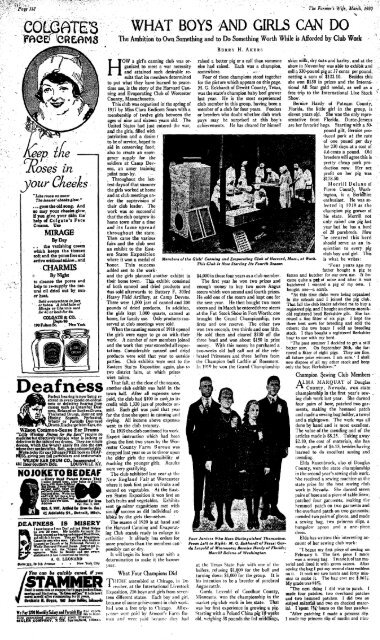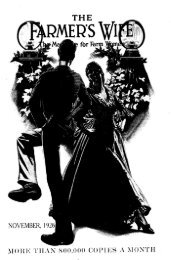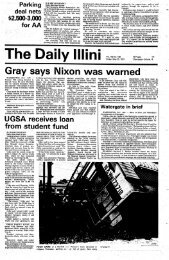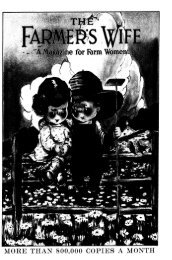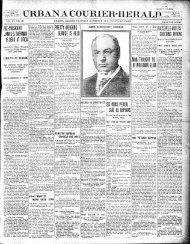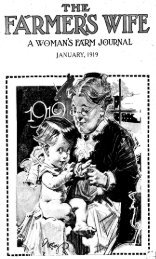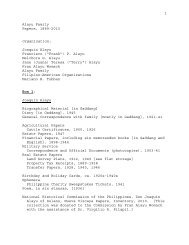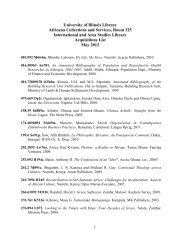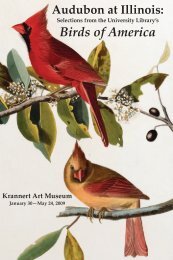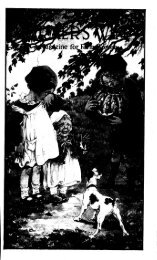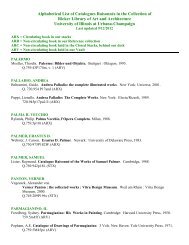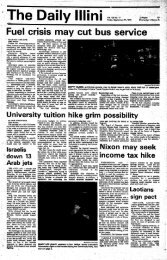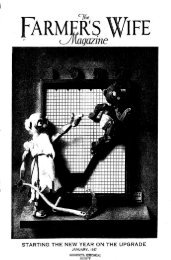H - University of Illinois
H - University of Illinois
H - University of Illinois
Create successful ePaper yourself
Turn your PDF publications into a flip-book with our unique Google optimized e-Paper software.
'.:•. - ¦ •. , ¦:¦ . * «*sc ' " " ¦<br />
'<br />
' •> ¦¦ ¦-<br />
- ' ,<br />
'<br />
:<br />
GOlltfiS<br />
FACer !CRtftM8<br />
WHAT BOYS AND GIRLS CAN DO<br />
The Ambition to Own Something and to Do Something Worth While is Ajjorded by Club Work<br />
B ERRY H. A KERS<br />
'¦ . <<br />
V* *\ ^©ffl^ ' ftj V'* /<br />
Jwses in<br />
your Cheeks<br />
"Like rosea on snots/<br />
The lassies' chemka How."<br />
...goes the old song. And<br />
so may your cheeks glow,<br />
if you give yout skin the'<br />
help <strong>of</strong> Colgate's Face<br />
Creams. Use<br />
MIRAGE<br />
By Day<br />
. . the vanishing cream<br />
which keeps the tissues<br />
s<strong>of</strong>t and the pores free and<br />
active withoutshine.. and<br />
CHARMIS<br />
-. By Night<br />
; ,-. to cleanse the pores and<br />
"¦' .% C<br />
help to re-supply the natural<br />
oil dried out by^ sun<br />
or heat.<br />
Sold everywhere in jars<br />
. or tubes. A trial tube <strong>of</strong><br />
Mirage or Chermis sent<br />
f or 4c or both f or 6c<br />
COLGATE & CO. .<br />
Dtp*. 90<br />
199 Fulton St . New York<br />
Deafness<br />
m\\\wSti\. Perfect hearing is now being r*<br />
t^HgsCa stored in every condition oi deal-<br />
/SsaVrVaV ness or defective Rearing from<br />
'rAltf.^.r causes such as Catarrhal Deaf•<br />
i \V& ^W ness. Relaxed or Sunken Drums.<br />
faC\ilnV */v Thickened Drurqs, Roaring and<br />
tekaMsX, SS«J» Hissing Sounds, Perforated,<br />
juBBMS Wholly or Partially Dest royed<br />
IfW&eSWsV* rV.Drums,Discha rge from Ears, etc.<br />
Wilson Common-Sense Ear Drums<br />
"Little Wireless Phones for the Ears" require no<br />
medicirretiuttffectivelyreplace what is lacking or<br />
defectiveintbenatural eardrums. They are simple<br />
devices, which the "sparer easily fits into the ears<br />
" where they are invisible. S<strong>of</strong>t, safe and comfortable.<br />
Write today lot our 168 page FREE book on DEAF-<br />
NESS, giving you full particulars and testimonials<br />
' WILSON EAR DRUM CO.. incorporated '.<br />
iSl lMer-Southerti Bldu. LOUISVULE. KY.<br />
NOJOKETO BEDEAF<br />
—Eirary Baal Parson Knows That<br />
I make jaiyaslf Iieer. after belne? deaf for g5<br />
maiaJrlttiUiesoArtikiafi^aV ajjfc<br />
1foprarM^ww J tB;em^H|^^B»^Bk<br />
rrtfncTOec^ortabb. - No^^^^^^^^ H ,<br />
caaeeM-tnero. Write , ina^^^^p VB t v a a a a a a JT<br />
aacrl will tell Poam,triU^*\\\\\T<br />
atojy/rSW I ant deaf and<br />
^kssw<br />
howl make yet: hear.<br />
J^. _^T<br />
IMittsM Elf DIM<br />
Address<br />
p.t. Hov. S. 1MB<br />
QE0. P. WAY, fcthWal En DIM C (lit.)<br />
f 41 Adelaide St., Detroit, Mich.<br />
DEAFNESS<br />
IS MISERY<br />
¦ - ¦ I know because I was Deal sad hid Head NbUea<br />
K_k lor over 30 rtsrs. Mr iayifible AnluroUe Est<br />
W4K Drams ratote4 my heariu sad steeped Head Nouei,<br />
I % and wHl do it to ' ryoii. Tber sitTiojr Megsphonn.<br />
IgjvvvL Caanot be seen wits woro. Effective when Dulaeu<br />
IW M it caused by Catarrh or by Perforated, Partially or<br />
¦AA Wholly Destroyed Natural Droral. . Easy to rot in,<br />
lav WJ easy to tale out. Are "Unseen Conuoru. Int*s*f»<br />
expensive. Write tor Booklet and my sworn<br />
W^J ' etntement oi how I recovered my hearing.<br />
***r<br />
A. o. LEONARD<br />
eultejSS,» 5tb Avenue • • New York City<br />
/ Yott cm be quickly cared, if you<br />
/STAMMER<br />
¦Smd 10 ctmtacoia or stamps for 70-nge book on Stamf<br />
BaxiagudStatterina.^ltaaiftam'IttclIaliml<br />
tf eared mys& alter etiunniexiiig lor 20 yean.<br />
m Benjtffilft N. Bogiie, 7*1 ttete tessat h&sspsh<br />
We Par gOOMonhMySalaryand FnmisliRig j^VfK' ;<br />
cluee guaranteed . poultry ami etock Powers. .<br />
•IDLER COMPANY , X J20, Springfield, Illlno.i<br />
a girl s canning club was organized<br />
to meet a war necessity<br />
HOW<br />
and attained such desirable results<br />
that its members determined<br />
to put what they have learned to peacetime<br />
use, is the story <strong>of</strong> the Harvard Canning<br />
and Evaporating Club <strong>of</strong> Worcester<br />
County, Massachusetts.<br />
This club was organized in' the spring <strong>of</strong><br />
1.917 by Miss Clara Endicott Sears with a<br />
membership <strong>of</strong> twelve girls between the<br />
ages <strong>of</strong> nine and sixteen years old. The<br />
United States had just entered- the war,<br />
and the girls, filled with<br />
patriotism and a desire<br />
to be <strong>of</strong> service, hoped to<br />
aid in conserving food;<br />
also to create an emergency<br />
supply for the<br />
soldiers at Camp Devens,<br />
an army training<br />
point-near- by.<br />
Throughout the hottest<br />
days <strong>of</strong> that summer<br />
the girls worked at home<br />
and at club meetings under<br />
the supervision <strong>of</strong><br />
their club leader. The<br />
work was so successful<br />
that the club outgrew its<br />
home town after a time<br />
and its fame spread<br />
throughout the state.<br />
Then came the various<br />
fairs and the club sent<br />
an exhibit to the Eastern<br />
States Exposition<br />
where it won a medal <strong>of</strong><br />
honor. This success<br />
added zest to the work<br />
and the girls planned another exhibit in<br />
their home town. This exhibit consisted<br />
<strong>of</strong> both canned and dried products and<br />
was sold afterwards to Battery F, 303rd<br />
Heavy Field Artillery, at Camp Devens.<br />
There were 1,000 jars <strong>of</strong> canned and 200<br />
pounds <strong>of</strong> dried products. In addition,<br />
the girls kept 1,000 quarts, canned at<br />
home, for family use. Only products conserved<br />
at club meetings were sold.<br />
When the canning season <strong>of</strong> 1918 opened<br />
the girls were eager to go on with;their<br />
work. A number <strong>of</strong> new members joined<br />
and the work that year exceeded all expectations.<br />
Considerable canned and dried<br />
products were sold that year to outside<br />
parties. Club exhibits were sent to the<br />
Eastern Sta^ss Exposition again, also to<br />
two district fairs, at which prizes<br />
were taken.<br />
That fall, at the close <strong>of</strong> the season ,<br />
another club exhibit was held in the<br />
town hall. After all expenses were<br />
paid, the club had $100 in cash,to its<br />
credit with 1,320 jars <strong>of</strong> products unsold.<br />
Each girl was paid that yeai<br />
for the time she spent in canning and<br />
drying. All income above expense?<br />
went to the cliib treasury.<br />
In 1919 the club continued its work.<br />
Expert instruction which had been<br />
given the first two years by the Worcester<br />
County Farm Bureau was<br />
dropped last year so as to throw ujion<br />
the older girls the responsibility <strong>of</strong><br />
(teaching the younger girls. Results<br />
were very gratifying.<br />
The club exhibited last year at the<br />
New England Fair at Worcester<br />
where it took first prize on fruits and<br />
second on vegetables. At the Eastern<br />
States Exposition it won first on<br />
both fruits and vegetables, Exhibits<br />
sent to minor expositions met with<br />
simil# success as did individual exhibits<br />
by .the girls themselves.<br />
The season <strong>of</strong> 1920 is at hand and<br />
the Harvard Canning and Evaporating<br />
Club stands ready to enlarge itsactivities<br />
It already has orders for<br />
more products than the members can<br />
possibly can or dry.<br />
It will begin its fourth year with a<br />
determination to make it the banner<br />
rear.<br />
What Four Champions Did<br />
THERE assembled at Chicago, in December,<br />
at the International Livestock<br />
Exposition, 216 boys and girls from seventeen<br />
different states. Each boy and girl ,<br />
because <strong>of</strong> some achievement in club work ,<br />
had won a free tri p to Chicago. All expanses<br />
were paid by Armour's Farm Bureau<br />
and were paid l iecause they had<br />
raised a better pig or a calf than someone<br />
else had raised. Each was a champion,<br />
somewhere. ,<br />
Four <strong>of</strong> these champions stood together<br />
for the picture which appears on this page.<br />
M. G. Eckhardt <strong>of</strong> Dewitt County, Texas,<br />
was the state's champion baby beef grower<br />
last year. He is the most experienced<br />
club member in this group, having been a<br />
member <strong>of</strong> a club for four years. Feeders<br />
or breeders who doubt whether club work<br />
pays may be surprised at this boy's<br />
achievements. He has cleared for himself<br />
Members <strong>of</strong> the Girls' Canning and Evapora ting Club <strong>of</strong> Harvard, Maes., at Work.<br />
This Club Is Now Starting Its Fourth Season<br />
$4,000 in those four years as a club member.<br />
The first year he won two prizes and<br />
enough money to buy two more Angus<br />
steers which won second and fourth prizes.<br />
He sold one <strong>of</strong> the steers and kept one for<br />
the next year. He then bought two more<br />
steers and in March he entered three steers<br />
at the Fat Stock Show in Fort Worth; one<br />
brought the Grand Championship, two<br />
firsts and one reserve. The other two<br />
won two seconds, two thirds and one fifth.<br />
He sold them and cleared §750 <strong>of</strong>f the<br />
three head and won about $150 in prize<br />
money. With this money he purchased a<br />
two-weeks old bull calf out <strong>of</strong> the celebrated<br />
Prizemere and three heifers from<br />
the Champion bull Laddie <strong>of</strong> Rosemere.<br />
In 1"10 he won the Grand Championship<br />
Four Juniors Who Have Distinguished Themselves.<br />
From Lef t to Right: M. G. Eckhardt <strong>of</strong> Texas; Gurda<br />
Lexoold <strong>of</strong> Minnesota ; Bernice Hardy <strong>of</strong> Florida;<br />
Morrill Delano <strong>of</strong> Washington<br />
at the Texas State Fair with one <strong>of</strong> the<br />
heifers, refusing $1,800 for the bull and<br />
turning down $4,000 for the group. It is<br />
his intention to be a breeder <strong>of</strong> purebred<br />
Angus cattle.<br />
Gurda Lexvold <strong>of</strong> Goodhue County,<br />
Minnesota , won the championship in the<br />
market pig-club work in her. state. That<br />
was her first experience in growing a pig.<br />
Starting with a Poland China pig 10 weeks<br />
old, weighing 38 pounds she fed middlings,<br />
skim milk, dry oats and barley, and at the<br />
show in November was able to exhibit and<br />
sell a 330-pound pig at 37 cents per pound,<br />
netting a sum <strong>of</strong> $122.10. Besides this<br />
she won $150 in prizes and the International<br />
All Star gold medal, as well as a<br />
free trip to the International Live Stock<br />
Showi<br />
Bernice Hardy <strong>of</strong> Putnam County,<br />
Florida, the little girl in the group, is<br />
eleven years old. She was the only representative<br />
from Florida. Duroc-Jerseys<br />
are her favorite hogs. Starting with a 50-<br />
pound gilt , Bernice produced<br />
pork at the rate<br />
<strong>of</strong> one pound per day<br />
for 230 days at a cost <strong>of</strong><br />
4.6 cents a pound. Old<br />
breeders will agree this is<br />
pretty cheap pork production<br />
now. Her net<br />
pr<strong>of</strong>it on her pig was<br />
$178.50.<br />
Morrill Delano <strong>of</strong><br />
Pierce County, Washington,<br />
is a Berkshire<br />
enthusiast. He was selected<br />
in 1919 as the<br />
champion pig grower <strong>of</strong><br />
his state. Morrill not<br />
only raised one pig last<br />
year but he has a herd<br />
<strong>of</strong> 28 purebreds. How<br />
he secured this herd<br />
should serve as an inspiration<br />
to every pig<br />
club boy and girl. This<br />
is what he writes:<br />
"Four years ago my<br />
father bought a pig to<br />
fatten and butcher for our own use. It became<br />
quite a pet <strong>of</strong> mine and after it was<br />
butchered I wanted a pig <strong>of</strong> my own. I<br />
bought one—a scrub.<br />
"At this time clubs were being organized<br />
in the schools and I joined the pig club.<br />
That fall the club leader advised me to buy a<br />
registered pig, and I bought an eleven-montliold<br />
registered bred Berkshire gilt. She farrowed<br />
a fine litter <strong>of</strong> six pigs. I kept the<br />
three best sows for breeding and sold the<br />
others; the two boars I sold as breeding<br />
stock. I then bought a registered Berkshire<br />
boar to use with my herd.<br />
"The past summer I decided to get a still<br />
better sow. On September 20th, she farrowed<br />
a fitter <strong>of</strong> eight pigs. They are fine,<br />
all future prize winners, I am sure. ' I shall<br />
now dispose <strong>of</strong> all my other stock and keep<br />
onlv the best Berkshires ."<br />
Champion Sewing Club Members<br />
ALMA MARQUAT <strong>of</strong> Douglas<br />
' County, Nevada, won state<br />
championship in the first year's sewing<br />
club work last year. She darned<br />
four pairs <strong>of</strong> hose, patched two garments,<br />
making the hemmed patch<br />
and made a sewing bag holder, a towel<br />
and a nightgown. The work was all<br />
done by hand and is most excellent.<br />
The value <strong>of</strong> the mending and <strong>of</strong> the<br />
articles made is $8.25. Taking away<br />
$2.10, the cost <strong>of</strong> materials, she has<br />
made a pr<strong>of</strong>it <strong>of</strong> $6.15, besides having<br />
learned to do excellent sewing and<br />
mending.<br />
Elda Rosenbrock , also <strong>of</strong> Douglas<br />
County, won the state championsh ip<br />
in the second year's sewing club work.<br />
She received a sewing machine as the<br />
state prize for the best sewing club<br />
work in Nevada. She darned seve n<br />
pairs <strong>of</strong> hose and a piece <strong>of</strong> table linen ;<br />
patched four garments, making the<br />
hemmed patch on two garments and<br />
the overhand patch on two garments;<br />
mended two pairs <strong>of</strong> gloves, and made<br />
a sewing bag, two princess slips, a<br />
bungalow apron and a one-piece<br />
dress.<br />
Elda has written this interesting account<br />
<strong>of</strong> her sewing club work:<br />
"I began my first piece <strong>of</strong> sewing on<br />
February 4. The first piece I made<br />
was a sewing bag. I made it <strong>of</strong> tan material<br />
and lined it with green sateen. After<br />
sewing the bag I put my second class emblem<br />
on it. It took me two hours and forty minutes<br />
to make it. The bag cost me $.86?j.<br />
My grade was 98%.<br />
"The next thing I did was to patch. I<br />
made four patches, two overhand patches<br />
and two hemmed patches. I did two on<br />
striped, ^material/and two on checked material.<br />
I spent 75^-hours on the four patches.<br />
"After patching I made a princess slip<br />
I made my princess slip <strong>of</strong> muslin and trim-


